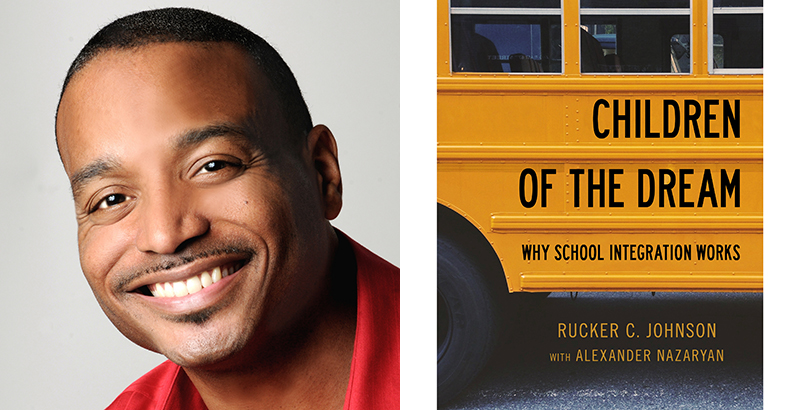74 Interview: Professor Rucker Johnson on How School Integration Helped Black Students — and How Much More Is Possible When It’s Paired With Early Education & Spending Reforms

Check out The 74’s coverage of the 65th anniversary of the Brown v. Board of Education decision, and the full archive of 74 interviews.
Most Americans believe that after the landmark Brown v. Board of Education decision, everyone tried their best to integrate schools and it just didn’t work. But that’s a myth, professor Rucker Johnson argues in a new book.
Johnson, in his new book Children of the Dream: Why School Integration Works, argues that integration did improve the academic and life outcomes of black students, and that America ignores those lessons at its peril, particularly as schools have become starkly re-segregated in recent decades.
“We’re both in a place where we have unprecedented racial diversity among our population of today’s schoolchildren … [and] the classrooms in which they’re being educated are hugely segregated, to the point that it’s really hard to detect that Brown ever occurred,” Johnson, a professor at the University of California, Berkeley, told The 74.
Johnson’s book, co-authored with Alexander Nazaryan, examines the effects of integration, particularly during the peak of desegregation in the 1970s and 1980s. The slow rollout of school desegregation efforts across the country meant that otherwise similar students were effectively divided into “treatment” groups that experienced integrated schools and “control” groups that did not. Data from school districts and a nationally representative data set of life outcomes, when paired with the “treatment” and “control” groups, let Johnson set up what he called “parallel universes” to evaluate the effects of desegregation.
Among his findings:
● Black children who experienced integrated schools from K-12 completed over a full year of education more than comparable black children in segregated schools.
● Five years in a desegregated school led to increased wages and work hours that, combined, came to a 30 percent increase in earnings.
● Exposure to desegregated schools in elementary school led to a 22-point decline in the probability the student would be incarcerated as an adult.
Johnson argues that a combination of three education policies — integration, high-quality preschool and school funding reforms that funnel more money into high-needs schools — is the best way to improve outcomes.
The following conversation has been edited for length and clarity.
The 74: Was there a golden age of school integration?
Rucker: It’s a 10-to-15-year window, and it wasn’t universal across the country. It depended on which district got that 10- or 15-year window. That’s actually being generous in some places. I definitely document a kind of golden period in which we were moving from desegregation to integration, and we were moving from access to inclusion, and we were moving from exposure to understanding. But as soon as those processes were really beginning to take hold, the politics of reform, the impatience that governs looking at just short-run test scores, and just the gravitational pull that incentivizes segregation [ended it].
I think there’s a number of factors that hijacked its continued success, but there was definitely a period in which we saw unprecedented narrowing of academic achievement gaps, of educational attainment. We saw widespread college enrollment rates among 18- and 19-year-old black students by the mid-’80s that had risen to the same level as white 18- and 19-year-olds. Then we’ve seen a significant stagnation and a widening of many of those academic achievement gaps, in some respects, but certainly not a narrowing of them.
I think what’s important about this work is it’s not just that these interventions can be profound in their transformative effects on educational outcomes, but it’s the way in which they have significant impacts in narrowing racial differences in earnings and the annual incidence of poverty in adulthood and adult health. It’s really recognizing that schools can play a pivotal role in the intergenerational transmission of either opportunity, poverty, or upward mobility. That’s what one key emphasis of the work is — that our schools can play a catalytic role in providing opportunity, but they can also play a role in reinscribing and reinforcing inequality and reproducing it.
How did you go about researching the book?
We’re following more than 15,000 kids from childhood to adulthood, but we’re able to really use data as a time machine to trace out the exposure of pre-school opportunities that they may have had, the exposure to [greater] per-pupil spending and [smaller] class size and the extent of school segregation … and then we’re able to look chronologically at their subsequent development and academic achievement … and then trace that further as they enter their 20s, 30s and 40s, to look at their adult earnings and their likelihood of being in poverty.
Those are pieces, but I would say one of the reasons we’re able to do that is precisely because the timing of school desegregation, the timing of school funding reforms in this country and the timing of the rollout of high-quality preschools have been uneven, and the kind of slow pace of that really created policy laboratory conditions to look at the interventions independent of other factors — to be able to isolate the role of school quality on these later life trajectories.
That’s the way that we do it in a quantitatively rigorous way, but that’s not really enough to get inside the black box of what is actually happening in the schools. That’s where our qualitative interviews really helped us — interviews with superintendents and teachers and jurists who presided over major court rulings around school funding reforms and school desegregation. [We could] couple the aerial view that’s coming from the quantitative data to the qualitative insights about how and the way in which the reforms are implemented, [in addition to looking at] how do those things matter and make the process of integration a reality.
Of all the findings in the book, is there any one that sticks out?
When you look at student outcomes and you look at the fact that we have significant achievement gaps today by socioeconomic status and race … I think what’s missed is [not only] how instrumental a role school policies can play in narrowing those gaps, but how inconsistently as a country we’ve committed to the investment in lower-income families and communities that can yield those results.
When I first started this book, I had done quite a bit of work on school desegregation by itself, but not as connected with school funding reforms or early pre-school investments … It’s really that synergy that was the big eye-opener that unlocked to me a lot of the answers for what’s plaguing our current educational investments, and the siloed ways in which we invest in kids, and invest much too late to address many of the challenges that face them.
Why did you decide to look at Head Start, when pre-K is still often seen as outside the public K-12 system?
A big descriptive fact that illuminates the significance of the pre-K environment is simply that half of the achievement gap that we observe among third-graders was already apparent at kindergarten entry. It became clear that what precedes the kindergarten experience has to close some of the school readiness gaps that exist by socioeconomic status.
Even today, half of 3- and 4-year-olds in California, which has had significant increases in public investments in pre-K, don’t have access to a high-quality pre-K. These are not just historical exercises in policy analysis but rather the kinds of implications that are very relevant today. There’s significant school spending disparities between low-income and more affluent communities.
[The lessons learned from this research] really bring dividends when we import those lessons into today’s contemporary debates about how to address the persistent opportunity gaps that exist between low-income children and their more affluent counterparts.Has any district ever achieved your ideal trifecta of integration, school finance reform and high-quality pre-school?
I don’t think that I could have done the analysis without there being some representative examples of that, but at the same time, they aren’t places that were able to sustain that commitment.
We don’t have a large number, for example, of high-poverty schools where kids systematically, year in and year out, are overcoming the odds. The reason for that is because there are significant challenges in just thinking you can throw money at the problem. The school funding reforms that redistribute state resources and dollars to lower-income communities, so that the health of their schools is not dependent on the wealth of their communities, has been a significant impact in narrowing achievement gaps. But at the same time, when all of those reforms are done in very segregated, concentrated poverty conditions, the return on those investments aren’t nearly as big and beneficial as when they’re able to be done in more integrated spaces.
We would like to have closed the book on highlighting a specific district that really had the hallmarks of this trifecta prescription that we’re describing, but you’ll notice the book doesn’t end on a specific district, because we weren’t really able to identify such a model that was sustained into today.
That’s kind of the point: A lot of the good work that was able to be done wasn’t documented in real time. When myopic politicians are focused on short-run budget deficits, sometimes very important public investments in children get undermined. Hopefully, the evidence will allow some of those efforts to be sustained so that all kids are getting better access to opportunity.
How would you evaluate current integration efforts?
I would say that they need to be resuscitated. I would say that they are in the hospital. I would say they are needing intensive care units. I would say they don’t have that much of a heartbeat.
It’s deeply concerning, and yet I think there’s a groundswell of movement that is positive and actually that is being mobilized through student voices and perspectives that we have found to really invigorate and revive the movement towards integration. Kids, who understand what being confined to segregated spaces contributes to their learning environment, are voicing these very important ideas. They have a strong research base. We need some courageous adults to have the conviction to get behind [them].
I think part of this is that it requires a coalition, and a racially diverse coalition. This is not a zero-sum game. This is not like benefits that positively affect minorities somehow negatively affect non-Hispanic whites. This is something that has the potential to boost all of our collective outcomes.
What other areas deserve more research?
I think the school choice movement and with charter schools … whether that is leading to a greater expansion of opportunity or actually cutting off many children from good opportunities.
Those are outstanding questions, in terms of the way gerrymandered school district boundaries are being used to exclude children of color and lower-income students from certain school communities. Those are real policy choices that are happening in ways that are re-segregating our schools. Those are things that we certainly try to highlight in the book, because those are things that aren’t happening by coincidence but through explicit policy designs for those aims.
Get stories like these delivered straight to your inbox. Sign up for The 74 Newsletter

;)
